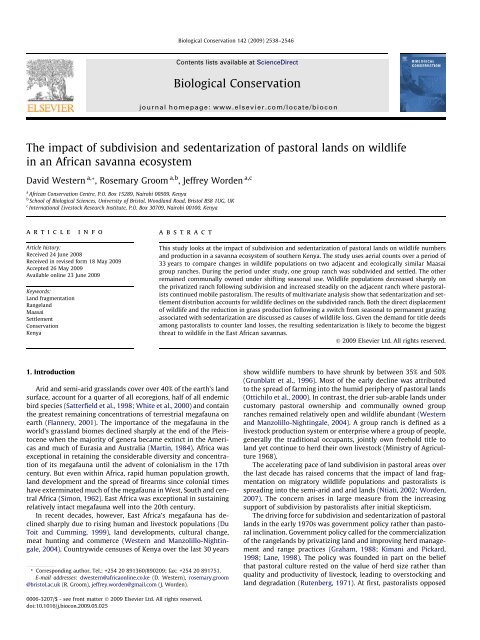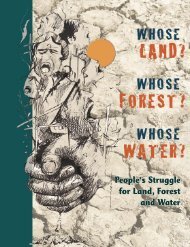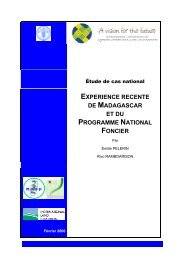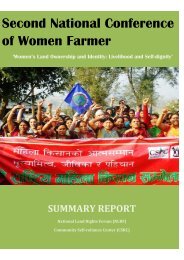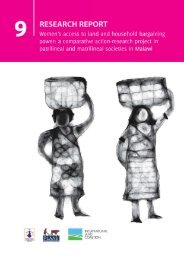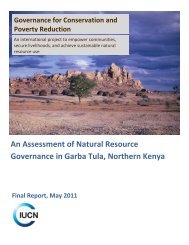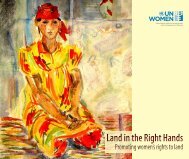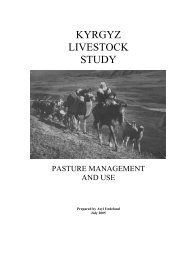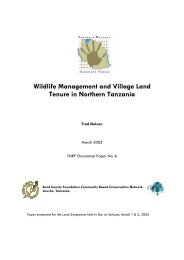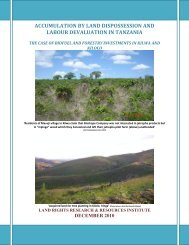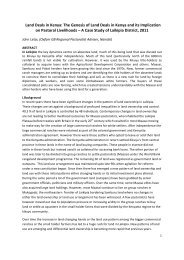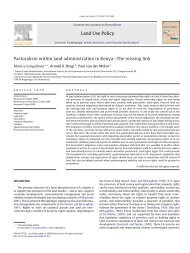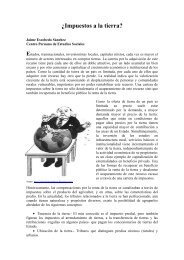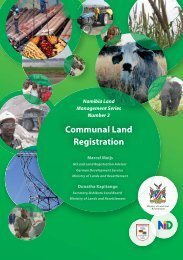The impact of subdivision and sedentarization of ... - Land Portal
The impact of subdivision and sedentarization of ... - Land Portal
The impact of subdivision and sedentarization of ... - Land Portal
You also want an ePaper? Increase the reach of your titles
YUMPU automatically turns print PDFs into web optimized ePapers that Google loves.
<strong>The</strong> <strong>impact</strong> <strong>of</strong> <strong>subdivision</strong> <strong>and</strong> <strong>sedentarization</strong> <strong>of</strong> pastoral l<strong>and</strong>s on wildlife<br />
in an African savanna ecosystem<br />
David Western a, *, Rosemary Groom a,b , Jeffrey Worden a,c<br />
a African Conservation Centre, P.O. Box 15289, Nairobi 00509, Kenya<br />
b School <strong>of</strong> Biological Sciences, University <strong>of</strong> Bristol, Woodl<strong>and</strong> Road, Bristol BS8 1UG, UK<br />
c International Livestock Research Institute, P.O. Box 30709, Nairobi 00100, Kenya<br />
article info<br />
Article history:<br />
Received 24 June 2008<br />
Received in revised form 18 May 2009<br />
Accepted 26 May 2009<br />
Available online 23 June 2009<br />
Keywords:<br />
L<strong>and</strong> fragmentation<br />
Rangel<strong>and</strong><br />
Maasai<br />
Settlement<br />
Conservation<br />
Kenya<br />
1. Introduction<br />
abstract<br />
Arid <strong>and</strong> semi-arid grassl<strong>and</strong>s cover over 40% <strong>of</strong> the earth’s l<strong>and</strong><br />
surface, account for a quarter <strong>of</strong> all ecoregions, half <strong>of</strong> all endemic<br />
bird species (Satterfield et al., 1998; White et al., 2000) <strong>and</strong> contain<br />
the greatest remaining concentrations <strong>of</strong> terrestrial megafauna on<br />
earth (Flannery, 2001). <strong>The</strong> importance <strong>of</strong> the megafauna in the<br />
world’s grassl<strong>and</strong> biomes declined sharply at the end <strong>of</strong> the Pleistocene<br />
when the majority <strong>of</strong> genera became extinct in the Americas<br />
<strong>and</strong> much <strong>of</strong> Eurasia <strong>and</strong> Australia (Martin, 1984). Africa was<br />
exceptional in retaining the considerable diversity <strong>and</strong> concentration<br />
<strong>of</strong> its megafauna until the advent <strong>of</strong> colonialism in the 17th<br />
century. But even within Africa, rapid human population growth,<br />
l<strong>and</strong> development <strong>and</strong> the spread <strong>of</strong> firearms since colonial times<br />
have exterminated much <strong>of</strong> the megafauna in West, South <strong>and</strong> central<br />
Africa (Simon, 1962). East Africa was exceptional in sustaining<br />
relatively intact megafauna well into the 20th century.<br />
In recent decades, however, East Africa’s megafauna has declined<br />
sharply due to rising human <strong>and</strong> livestock populations (Du<br />
Toit <strong>and</strong> Cumming, 1999), l<strong>and</strong> developments, cultural change,<br />
meat hunting <strong>and</strong> commerce (Western <strong>and</strong> Manzolillo-Nightingale,<br />
2004). Countrywide censuses <strong>of</strong> Kenya over the last 30 years<br />
* Corresponding author. Tel.: +254 20 891360/890209; fax: +254 20 891751.<br />
E-mail addresses: dwestern@africaonline.co.ke (D. Western), rosemary.groom<br />
@bristol.ac.uk (R. Groom), jeffrey.worden@gmail.com (J. Worden).<br />
0006-3207/$ - see front matter Ó 2009 Elsevier Ltd. All rights reserved.<br />
doi:10.1016/j.biocon.2009.05.025<br />
Biological Conservation 142 (2009) 2538–2546<br />
Contents lists available at ScienceDirect<br />
Biological Conservation<br />
journal homepage: www.elsevier.com/locate/biocon<br />
This study looks at the <strong>impact</strong> <strong>of</strong> <strong>subdivision</strong> <strong>and</strong> <strong>sedentarization</strong> <strong>of</strong> pastoral l<strong>and</strong>s on wildlife numbers<br />
<strong>and</strong> production in a savanna ecosystem <strong>of</strong> southern Kenya. <strong>The</strong> study uses aerial counts over a period <strong>of</strong><br />
33 years to compare changes in wildlife populations on two adjacent <strong>and</strong> ecologically similar Maasai<br />
group ranches. During the period under study, one group ranch was subdivided <strong>and</strong> settled. <strong>The</strong> other<br />
remained communally owned under shifting seasonal use. Wildlife populations decreased sharply on<br />
the privatized ranch following <strong>subdivision</strong> <strong>and</strong> increased steadily on the adjacent ranch where pastoralists<br />
continued mobile pastoralism. <strong>The</strong> results <strong>of</strong> multivariate analysis show that <strong>sedentarization</strong> <strong>and</strong> settlement<br />
distribution accounts for wildlife declines on the subdivided ranch. Both the direct displacement<br />
<strong>of</strong> wildlife <strong>and</strong> the reduction in grass production following a switch from seasonal to permanent grazing<br />
associated with <strong>sedentarization</strong> are discussed as causes <strong>of</strong> wildlife loss. Given the dem<strong>and</strong> for title deeds<br />
among pastoralists to counter l<strong>and</strong> losses, the resulting <strong>sedentarization</strong> is likely to become the biggest<br />
threat to wildlife in the East African savannas.<br />
Ó 2009 Elsevier Ltd. All rights reserved.<br />
show wildlife numbers to have shrunk by between 35% <strong>and</strong> 50%<br />
(Grunblatt et al., 1996). Most <strong>of</strong> the early decline was attributed<br />
to the spread <strong>of</strong> farming into the humid periphery <strong>of</strong> pastoral l<strong>and</strong>s<br />
(Ottichilo et al., 2000). In contrast, the drier sub-arable l<strong>and</strong>s under<br />
customary pastoral ownership <strong>and</strong> communally owned group<br />
ranches remained relatively open <strong>and</strong> wildlife abundant (Western<br />
<strong>and</strong> Manzolillo-Nightingale, 2004). A group ranch is defined as a<br />
livestock production system or enterprise where a group <strong>of</strong> people,<br />
generally the traditional occupants, jointly own freehold title to<br />
l<strong>and</strong> yet continue to herd their own livestock (Ministry <strong>of</strong> Agriculture<br />
1968).<br />
<strong>The</strong> accelerating pace <strong>of</strong> l<strong>and</strong> <strong>subdivision</strong> in pastoral areas over<br />
the last decade has raised concerns that the <strong>impact</strong> <strong>of</strong> l<strong>and</strong> fragmentation<br />
on migratory wildlife populations <strong>and</strong> pastoralists is<br />
spreading into the semi-arid <strong>and</strong> arid l<strong>and</strong>s (Ntiati, 2002; Worden,<br />
2007). <strong>The</strong> concern arises in large measure from the increasing<br />
support <strong>of</strong> <strong>subdivision</strong> by pastoralists after initial skepticism.<br />
<strong>The</strong> driving force for <strong>subdivision</strong> <strong>and</strong> <strong>sedentarization</strong> <strong>of</strong> pastoral<br />
l<strong>and</strong>s in the early 1970s was government policy rather than pastoral<br />
inclination. Government policy called for the commercialization<br />
<strong>of</strong> the rangel<strong>and</strong>s by privatizing l<strong>and</strong> <strong>and</strong> improving herd management<br />
<strong>and</strong> range practices (Graham, 1988; Kimani <strong>and</strong> Pickard,<br />
1998; Lane, 1998). <strong>The</strong> policy was founded in part on the belief<br />
that pastoral culture rested on the value <strong>of</strong> herd size rather than<br />
quality <strong>and</strong> productivity <strong>of</strong> livestock, leading to overstocking <strong>and</strong><br />
l<strong>and</strong> degradation (Rutenberg, 1971). At first, pastoralists opposed
or ignored government policy on the grounds that their herds<br />
needed to move seasonally to maintain milk yields <strong>and</strong> avoid harsh<br />
droughts (Western <strong>and</strong> Manzolillo-Nightingale, 2004). This view<br />
was given weight by a number <strong>of</strong> studies showing that traditional<br />
pastoralism was not only as productive as commercial ranching,<br />
but highly adapted to the dryl<strong>and</strong>s by virtue <strong>of</strong> resilient livestock<br />
breeds <strong>and</strong> seasonal migrations (Western, 1982; Ellis <strong>and</strong> Swift,<br />
1988).<br />
<strong>The</strong>se studies, together with emerging ecological views on the<br />
importance <strong>of</strong> scale <strong>and</strong> mobility to the productivity <strong>and</strong> resilience<br />
<strong>of</strong> the dryl<strong>and</strong>s (Walker <strong>and</strong> Noy-Meir, 1982; McNaughton, 1985),<br />
led to concerns that l<strong>and</strong> <strong>subdivision</strong> is a threat to pastoral livelihoods<br />
<strong>and</strong> wildlife alike. <strong>The</strong> continuing relevance <strong>of</strong> these concerns<br />
was recently highlighted in exchanges between East<br />
African pastoralists <strong>and</strong> American ranchers. <strong>The</strong> exchanges focused<br />
on the degradation caused by a century <strong>of</strong> l<strong>and</strong> parceling <strong>and</strong> livestock<br />
development in the arid west <strong>of</strong> the United States (Curtin <strong>and</strong><br />
Western, 2008).<br />
Despite continuing concerns over their inability to survive on<br />
small <strong>subdivision</strong>s, most pastoralists now support <strong>subdivision</strong><br />
(Ntiati, 2002) for fear <strong>of</strong> losing their l<strong>and</strong> to outsiders (Manzolillo-Nightingale<br />
<strong>and</strong> Western, 2006). Other factors contributing to<br />
this shift in attitude include rising population pressure, poverty,<br />
alienation <strong>of</strong> l<strong>and</strong> for farming <strong>and</strong> conservation, <strong>and</strong> the influence<br />
<strong>of</strong> market economies (Rutten, 1992). Even as they await legal <strong>subdivision</strong>,<br />
<strong>and</strong> <strong>of</strong>ten to accelerate the process, many pastoralists are<br />
voluntarily settling wherever water <strong>and</strong> social services permit,<br />
resulting in locally clustered <strong>sedentarization</strong>.<br />
<strong>The</strong> pace <strong>of</strong> <strong>subdivision</strong> is likely to see most <strong>of</strong> the remaining<br />
open pastoral l<strong>and</strong>s around Kenya’s premier protected areas carved<br />
into small allotments within the next several years. <strong>The</strong> parks <strong>and</strong><br />
reserves most at risk include Masai Mara, Amboseli, Tsavo West<br />
Narok<br />
District<br />
Tanzania<br />
Mbirikani<br />
Kaputei<br />
Amboseli-Tsavo Ecosystem<br />
Protected areas<br />
Country boundaries<br />
D. Western et al. / Biological Conservation 142 (2009) 2538–2546 2539<br />
Kajiado<br />
District<br />
Kenya<br />
Amboseli NP<br />
<strong>and</strong> Nairobi National Park. A number <strong>of</strong> recent articles have drawn<br />
attention to the threat <strong>of</strong> legal <strong>subdivision</strong> but <strong>of</strong>fer no quantification<br />
<strong>of</strong> the nature <strong>of</strong> its <strong>impact</strong> or its likely scale (Rutten, 1992;<br />
Kimani <strong>and</strong> Pickard, 1998; Ntiati, 2002; Worden, 2007).<br />
<strong>The</strong> lack <strong>of</strong> quantification on the <strong>impact</strong> <strong>of</strong> <strong>subdivision</strong> stems<br />
from the lack <strong>of</strong> case studies comparing the response <strong>of</strong> wildlife<br />
on legally subdivided group ranches to ecologically similar group<br />
ranches under continued mobile pastoralism. One <strong>of</strong> the few areas<br />
where the <strong>impact</strong> <strong>of</strong> <strong>subdivision</strong> has been studied is the Amboseli<br />
ecosystem in the Kajiado district <strong>of</strong> Kenya. Here several studies<br />
have begun to look at the <strong>impact</strong> <strong>of</strong> <strong>subdivision</strong> on pastoral societies<br />
(Ntiati, 2002; BurnSilver <strong>and</strong> Mwangi, 2007; Groom, 2007;<br />
Worden, 2007; Burnsilver et al., 2008) <strong>and</strong> the consequences for<br />
wildlife (Groom, 2007; Worden, 2007). <strong>The</strong>se studies suggest that<br />
l<strong>and</strong> fragmentation will reduce herd productivity <strong>and</strong> increase<br />
the drought risk to pastoralists, particularly among poorer families<br />
(Worden, 2007). Worden (2007) also gives some evidence to show<br />
that wildlife numbers decline significantly in the vicinity <strong>of</strong> permanent<br />
settlements compared to seasonally mobile settlements.<br />
One <strong>of</strong> the weaknesses <strong>of</strong> post-hoc studies comparing<br />
subdivided <strong>and</strong> un-subdivided locations is that they lack the<br />
before-<strong>and</strong>-after control for distinguishing ecological from l<strong>and</strong><br />
use differences (e.g. Groom, 2007). One study that does provide before<br />
<strong>and</strong> after control is the Amboseli Research <strong>and</strong> Conservation<br />
Program (Western, 1994). Established in 1967, the study covers<br />
both the Ilkisongo section <strong>and</strong> the transition from free-ranging traditional<br />
pastoralism to <strong>subdivision</strong> in the Kaputei section <strong>of</strong><br />
Maasail<strong>and</strong>.<br />
Here we draw on a 33-year ecological monitoring program to<br />
look at the <strong>impact</strong> <strong>of</strong> legal <strong>subdivision</strong> on wildlife in Kaputei section<br />
compared to the adjacent Ilkisongo section where mobile pastoral<br />
herding practices continued. We assess the <strong>impact</strong> <strong>of</strong><br />
Chyulu Hills NP<br />
Kenya<br />
200 0 200 400 Kilometers<br />
Tsavo NP<br />
Indian<br />
Ocean<br />
Fig. 1. Map <strong>of</strong> the study area in Kajiado District <strong>of</strong> Kenya (grey). <strong>The</strong> area covered by the aerial counts (black) encompasses Amboseli National Park <strong>and</strong> borders Tsavo<br />
National Park to the east (protected areas are dotted). <strong>The</strong> inset shows the location <strong>of</strong> the study area within Kenya.
2540 D. Western et al. / Biological Conservation 142 (2009) 2538–2546<br />
<strong>subdivision</strong> on 17 large herbivore species using before <strong>and</strong> after<br />
measures on adjacent subdivided <strong>and</strong> un-subdivided ranches.<br />
<strong>The</strong> species counted included zebra (Equus burchelli), wildebeest<br />
(Connochaetes taurinus), kongoni (Alcelaphus buselaphus), Thompson’s<br />
gazelle (Gazella thomsonii), Grant’s gazelle (Gazella granti),<br />
impala (Aepyceros melampus), oryx (Oryx beisa), el<strong>and</strong> (Taurotragus<br />
oryx), buffalo (Syncerus caffer), elephant (Loxodonta africana), giraffe<br />
(Giraffa cameleopardis), ostrich (Struthio camelus), gerenuk<br />
(Litocranius walleri), black rhino (Diceros bicornis), warthog (Phacochoerus<br />
africana), lesser kudu (Tragelaphus imberbis), <strong>and</strong> waterbuck<br />
(Kobus ellipsiprymnus).<br />
1.1. Study area<br />
<strong>The</strong> 14 sections <strong>of</strong> Maasail<strong>and</strong> cover a wide range <strong>of</strong> climatic<br />
<strong>and</strong> ecological conditions (Jacobs, 1965). Subdivision has occurred<br />
in the wetter rather than drier portions <strong>of</strong> the rangel<strong>and</strong>s, introducing<br />
an ecological bias into a comparative study <strong>of</strong> the <strong>impact</strong><br />
<strong>of</strong> <strong>sedentarization</strong> on savanna ecosystems. To minimize this bias,<br />
we studied two adjacent sections <strong>of</strong> Maasail<strong>and</strong>, Kaputei <strong>and</strong> Ilkisongo,<br />
both in eastern Kajiado District, southern Kenya (Fig. 1).<br />
<strong>The</strong> two ranches share a similar climate <strong>and</strong> ecology (Groom,<br />
2007). Aerial counts <strong>of</strong> eastern Kajiado by one <strong>of</strong> us (DW) have<br />
been conducted since the early 1970s (Fig. 1). Within the count<br />
area we selected the Kaputei ranches <strong>and</strong> Mbirikani group ranch<br />
for comparison. Mobile pastoralism was practiced on both ranches<br />
until the 1970s. In the late 1970s, however, Kaputei was subdivided<br />
into individual private ranches. Mbirikani remained communal<br />
<strong>and</strong> open to herders <strong>and</strong> wildlife, with the exception <strong>of</strong> a small<br />
strip in the west <strong>of</strong> the ranch. In that strip, in the 1980s, a number<br />
<strong>of</strong> families voluntarily settled along the Loitokitok–Sultan Hamud<br />
water pipeline (Fig. 2).<br />
Both ranches are semi-arid <strong>and</strong> classified as Agroclimatic Zones<br />
V <strong>and</strong> VI (Sombroek et al., 1982). In Amboseli, mean monthly maximum<br />
temperatures range from the mid-30s °C in February to low<br />
20s °C in July (Altmann et al., 2002). No in situ climate records are<br />
available due to the dearth <strong>of</strong> climate stations in the study area. To<br />
characterize the rainfall patterns in the two areas we used satellite<br />
derived rainfall estimates generated from cold cloud duration <strong>and</strong><br />
rainfall station data (African Data Dissemination Service http://earlywarning.usgs.gov/adds/).<br />
Rainfall on both ranches ranged between<br />
350 <strong>and</strong> 700 mm annually over the last 12 years. To<br />
determine the magnitude <strong>of</strong> difference in rainfall between the<br />
two areas we performed a paired t-test, further calculating an effect<br />
size using the pooled st<strong>and</strong>ard deviation <strong>of</strong> total annual<br />
(t = 1.14, p = 0.277) <strong>and</strong> mean monthly rainfall (t = 0.76,<br />
p = 0.461). An effect size <strong>of</strong> 0.116 for annual rainfall indicated a<br />
non-overlap <strong>of</strong> less than 14.7% in mean annual rainfall distributions<br />
in the two areas (over 85% overlap). Similarly, an effect size<br />
<strong>of</strong> 0.06 for the mean monthly rainfall indicated a small non-overlap<br />
<strong>of</strong> less that 7.7% (over 92% overlap) in the mean month by month<br />
rainfall distributions in the two group ranches. <strong>The</strong>re is a slight<br />
rainfall gradient across both ranches associated with the Ukambani<br />
upl<strong>and</strong>s to the north <strong>and</strong> the Chyulu Hills to the east. Rainfall is bimodal,<br />
with short rains generally falling in November <strong>and</strong> December<br />
<strong>and</strong> long rains from March to May (Ntiati, 2002). Droughts are<br />
frequent. During the past century droughts were recorded in 1933–<br />
1935, 1943–1946, 1948–1949, 1952–1953, 1960–1961, 1972–<br />
Fig. 2. Map <strong>of</strong> the study area showing the 5 5 km grids covered in aerial counts <strong>of</strong> eastern Kajiado since 1973 <strong>and</strong> the boundaries <strong>of</strong> the two study ranches, Kaputei <strong>and</strong><br />
Mbirikani, relative to Amboseli National Park. <strong>The</strong> voluntarily settled portion <strong>of</strong> Mbirikani is shown along the pipeline together with the density <strong>and</strong> dispersal <strong>of</strong> settlements<br />
on both ranches.
1976, 1983–1984 <strong>and</strong> 1994–1995 (Campbell, 1999). So far this<br />
century 2001 <strong>and</strong> 2005–2006 have been severe drought years<br />
(Ojwang et al., 2006). <strong>The</strong> severest drought in the 33-year study occurred<br />
in 1973–1976. Wildlife <strong>and</strong> livestock numbers fell during<br />
this drought <strong>and</strong> rose again in the ensuing wet years (Western,<br />
1994).<br />
<strong>The</strong> ecology <strong>of</strong> the Amboseli ecosystem prior to <strong>subdivision</strong> has<br />
been described in detail in Western (1973, 1994). Wildlife <strong>and</strong> livestock<br />
migrated widely during the rains <strong>and</strong> concentrated in the<br />
Amboseli Basin to the south, the Chyulu Hills to the east <strong>and</strong> the<br />
plains north <strong>of</strong> Sultan Hamud during the dry season.<br />
<strong>The</strong> Kaputei ranches included in our study cover 1364 km 2 in<br />
total, divided among 15 individual ranches (Fig. 2). <strong>The</strong> Chyulu<br />
Hills National Park borders the Kaputei ranches to the southeast.<br />
<strong>The</strong> Nairobi–Mombasa highway lies to the north. <strong>The</strong>re are approximately<br />
16,000 Kaputei Maasai living on Kaputei ranches <strong>and</strong><br />
80–100,000 head <strong>of</strong> livestock, based on aerial counts (see results).<br />
Until the late 1970s, water was sparsely distributed in the south<br />
<strong>and</strong> east. In the 1980s, the pipeline passing through the western<br />
part <strong>of</strong> the Kaputei ranches to the Mombasa Road was tapped to<br />
provide a string <strong>of</strong> new watering points. New dams <strong>and</strong> boreholes<br />
have also been constructed. <strong>The</strong>se developments have made daily<br />
watering possible over most <strong>of</strong> the ranches.<br />
Mbirikani Group Ranch covers 1331 km 2 , bordered on the eastern<br />
edge by the Chyulu Hills National Park <strong>and</strong> on its western<br />
boundary by Amboseli National Park (Fig. 2). <strong>The</strong> group ranch is<br />
owned <strong>and</strong> run communally by over 4000 members <strong>of</strong> Ilkisongo<br />
Maasai (Groom, 2007). Based on aerial counts (see results), there<br />
are approximately 12,000–16,000 people living on the ranch, along<br />
with some 50–80,000 head <strong>of</strong> livestock. Permanent water on the<br />
ranch is scarce <strong>and</strong> is restricted to a few swamps <strong>and</strong> rivers in<br />
the south <strong>of</strong> the group ranch <strong>and</strong> water outlets along the pipeline<br />
to the west. As a result, most herders drive livestock further to<br />
water than on Kaputei <strong>and</strong> water them less frequently (DW, personal<br />
observation).<br />
1.2. L<strong>and</strong> <strong>subdivision</strong> <strong>and</strong> settlement<br />
Kajiado District was divided into 52 group ranches after the<br />
passage <strong>of</strong> the L<strong>and</strong> Group Representatives Act <strong>of</strong> 1968 (Kimani<br />
<strong>and</strong> Pickard, 1998). Group ranch titles were given to the customary<br />
pastoral communities. <strong>The</strong> southern Kaputei section was divided<br />
into 15 small group ranches in the early to mid-1970s (Njoka,<br />
1979). <strong>The</strong> group ranches averaged 150 km 2 in size. <strong>The</strong> group<br />
ranches were further subdivided into individual private ranches<br />
in the early 1980s (Kimani <strong>and</strong> Pickard, 1998). On one group ranch<br />
studied intensively by Groom (2007), the mean size <strong>of</strong> the individual<br />
plots was 1.5 km 2 (0.7–4.6 km 2 ) <strong>and</strong> plots were separated<br />
mostly by thorn fencing. We refer to these private ranches collectively<br />
as the Kaputei ranches.<br />
<strong>The</strong> Ilkisongo section was divided into several large group<br />
ranches in the mid-1970s, including the Mbirikani Group Ranch.<br />
Of the six group ranches in Ilkisongo, only Kimana has been entirely<br />
subdivided. Mbirikani group ranch has only subdivided a<br />
small arable portion <strong>of</strong> its l<strong>and</strong> adjoining Kimana. Subdivision <strong>of</strong><br />
the remaining l<strong>and</strong>s is now (2009) progressing rapidly but had<br />
not taken place during our study period (1972–2006).<br />
<strong>The</strong> division <strong>of</strong> Kaputei into individual ranches led to <strong>sedentarization</strong><br />
in the 1980s. Each owner attempted to settle his l<strong>and</strong> <strong>and</strong><br />
manage livestock on his own holding. <strong>The</strong> group ranch designation<br />
<strong>of</strong> Mbirikani, in contrast, gave occupants joint title to the l<strong>and</strong>, but<br />
did not initially change traditional seasonal migrations or foraging<br />
strategies. A comparison <strong>of</strong> the pre- <strong>and</strong> post-settlement changes<br />
on Kaputei <strong>and</strong> Mbirikani therefore provides a natural experiment<br />
<strong>of</strong> the <strong>impact</strong> <strong>of</strong> legal l<strong>and</strong> <strong>subdivision</strong> (privatization) on wildlife<br />
abundance <strong>and</strong> seasonal movements.<br />
D. Western et al. / Biological Conservation 142 (2009) 2538–2546 2541<br />
2. Methods<br />
<strong>The</strong> two areas selected for comparative study, the Kaputei<br />
ranches <strong>and</strong> Mbirikani Group Ranch, were similar in terms <strong>of</strong> environmental<br />
characteristics, wildlife ecology, human population<br />
density <strong>and</strong> patterns <strong>of</strong> livestock use at the start <strong>of</strong> study in<br />
1973. Livestock densities were, however, higher on Kaputei than<br />
Mbirikani. Differences in l<strong>and</strong> tenure patterns between Kaputei<br />
<strong>and</strong> Mbirikani were used in a natural experiment (cf Hsieh et al.,<br />
2006). <strong>The</strong> Kaputei ranches were used as the experimental treatment<br />
to test the <strong>impact</strong> <strong>of</strong> <strong>subdivision</strong> on wildlife. Mbirikani was<br />
used as the control representing continued mobile pastoralism.<br />
We used 29 aerial counts covering the period 1974–2006 to<br />
study the <strong>impact</strong> <strong>of</strong> l<strong>and</strong> <strong>subdivision</strong> on wildlife. <strong>The</strong> 33-year study<br />
was divided into three periods, corresponding to the settlement<br />
phases on Kaputei independently <strong>of</strong> the analysis. <strong>The</strong> divisions<br />
were determined by the course <strong>of</strong> legal <strong>subdivision</strong> <strong>and</strong> from continuous<br />
observations by DW over the actual physical progress <strong>of</strong><br />
<strong>subdivision</strong>. Little permanent settlement took place on Kaputei before<br />
legal <strong>subdivision</strong> across all the ranches in the early 1980s. Until<br />
then, permanent settlement was confined to the north <strong>of</strong> the<br />
ranch close to the Mombasa Road. We refer to the period before<br />
1982 as the pre-settlement phase. Permanent settlement began<br />
over most <strong>of</strong> the Kaputei ranches in the early 1980s. Settlement<br />
was slow <strong>and</strong> erratic at first, due to the traditional inclination <strong>of</strong><br />
pastoralists to move in response to drought <strong>and</strong> rains. By the early<br />
1990s, most pastoralists had settled or attempted to settle. We refer<br />
to the period from 1982 to 1992 as the settlement phase. We<br />
refer to the period from 1992 onwards as the post-settlement<br />
phase. No <strong>subdivision</strong> took place on Mbirikani during this time, except<br />
for opportunistic voluntary settlement along the pipeline in<br />
the mid-to late 1980s, amounting to 20% <strong>of</strong> the group ranch<br />
(Fig. 2).<br />
In comparing changes in wildlife <strong>and</strong> livestock production on<br />
Mbirikani <strong>and</strong> Kaputei, we found the results were not significantly<br />
affected by the inclusion <strong>of</strong> the pipeline area. However, because<br />
this study is concerned with the <strong>impact</strong> <strong>of</strong> permanent settlement<br />
resulting from l<strong>and</strong> <strong>subdivision</strong> <strong>and</strong> privatization, we excluded<br />
the pipeline section <strong>of</strong> Mbirikani because <strong>of</strong> the permanent clustered<br />
settlements it contained (Fig. 2).<br />
<strong>The</strong> aerial counting method used has been described fully in<br />
Pennycuick <strong>and</strong> Western (1972) <strong>and</strong> Western (1976). <strong>The</strong> counts<br />
covered 8500 km 2 , divided into UTM grids measuring 5 km on a<br />
side. Transect lines were flown through the centre <strong>of</strong> each grid<br />
on a north–south axis 90 m above ground. Counting strips were<br />
nominally 150–200 m wide. Within each strip, rear-seat observers<br />
counted all wild <strong>and</strong> domestic animals the size <strong>of</strong> Thomson gazelles<br />
(25 kg) <strong>and</strong> larger. Animal herds too numerous to count by<br />
eye were photographed <strong>and</strong> later counted under a binocular microscope.<br />
<strong>The</strong> sample fraction was typically 8–10% <strong>of</strong> total counting<br />
area. Population estimates were calculated from the sample fraction<br />
using the Jolly II equation (Jolly, 1969). Settlements were<br />
counted according to type. <strong>The</strong>se included traditional Maasai dung<br />
huts, thatch-ro<strong>of</strong>ed huts, tin-ro<strong>of</strong>ed huts <strong>and</strong> brick buildings. All<br />
non-traditional Maasai hut types are permanent. In recent years<br />
an increasing number <strong>of</strong> traditional huts have also become permanent<br />
(Worden, 2007). All settlement types were combined in<br />
assessing the <strong>impact</strong> <strong>of</strong> settlements on wildlife.<br />
Wildlife <strong>and</strong> livestock population estimates <strong>of</strong> Kaputei <strong>and</strong><br />
Mbirikani were calculated from the counting grids covering each<br />
ranch. However, scaling down population estimates from the entire<br />
Ilkisongo ecosystem to ranch levels greatly inflated the st<strong>and</strong>ard<br />
error <strong>of</strong> estimates due to both the fewer sampling units <strong>and</strong><br />
the seasonality <strong>of</strong> wildlife movements on the ranches. <strong>The</strong> total<br />
Ilkisongo Monitoring System covered 8500 km 2 using 22 transect
2542 D. Western et al. / Biological Conservation 142 (2009) 2538–2546<br />
lines up to 100 km+ in length, <strong>and</strong> encompassed wet <strong>and</strong> dry season<br />
wildlife ranges. In contrast, Kaputei <strong>and</strong> Mbirikani ranches covered<br />
15% <strong>of</strong> that area, included half as many aerial transects<br />
averaging one third the length, <strong>and</strong> had seasonal wildlife<br />
movements.<br />
To reduce the dilution effect <strong>of</strong> small sampling units on the<br />
st<strong>and</strong>ard errors, we pooled the individual species numbers to derive<br />
total wildlife production, total livestock production <strong>and</strong> combined<br />
wildlife <strong>and</strong> livestock production. We initially look at the<br />
<strong>impact</strong> <strong>of</strong> <strong>subdivision</strong> on aggregated wildlife numbers. We subsequently<br />
converted wildlife numbers into aggregated production<br />
figures for two reasons. First, the use <strong>of</strong> production figures rather<br />
than total population counts normalizes the difference in area between<br />
the two ranches by giving a unit area figure. Second, production<br />
rather than numbers <strong>and</strong> densities takes into account<br />
differences in metabolism <strong>and</strong> turnover rates among species to<br />
give a common energetic equivalence per unit area for all species<br />
(Coe et al., 1975). Animal production was calculated for each species<br />
using the equation P = N 13.8Ms 0.67 , where N is the population<br />
size or density <strong>and</strong> Ms is the mean kcal equivalent <strong>of</strong> adult mass<br />
(Western, 1983). Unit weights were based on values given in Western<br />
(1973). <strong>The</strong> mass scaling exponent <strong>of</strong> 0.67 was used rather<br />
than 0.75 for consistency <strong>and</strong> comparison with earlier work in<br />
the Amboseli Ecosystem (Western 1991). <strong>The</strong> most appropriate<br />
scaling exponent (Glazier, 2005; White <strong>and</strong> Seymour, 2005; Clauss<br />
et al., 2007; Beuchat et al., 1997) is a subject <strong>of</strong> debate but will not<br />
affect the outcome <strong>of</strong> our results.<br />
To determine the <strong>impact</strong> <strong>of</strong> <strong>subdivision</strong> on wildlife, we used<br />
three measures <strong>of</strong> human activity <strong>and</strong> three measures <strong>of</strong> wildlife<br />
response. Measures <strong>of</strong> human activity included total livestock production,<br />
total number <strong>of</strong> huts as a measure <strong>of</strong> settlement density,<br />
<strong>and</strong> the proportion <strong>of</strong> grids with any settlement as a measure <strong>of</strong><br />
the spatial distribution <strong>of</strong> human activity. <strong>The</strong> average number <strong>of</strong><br />
occupants per hut was 4.54 for traditional huts, 4.08 for thatched<br />
huts <strong>and</strong> 4.36 for tin-ro<strong>of</strong>ed or brick huts. <strong>The</strong>se numbers were derived<br />
from questionnaire surveys in 2005/2006 (Groom, 2007) <strong>and</strong><br />
are similar to hut counts in the 1970s Western, D (unpublished<br />
data). <strong>The</strong> number <strong>of</strong> occupants per hut has thus remained relatively<br />
constant over the study period <strong>and</strong> gives a direct <strong>and</strong> reliable<br />
measure <strong>of</strong> human population size. Settlement numbers also give a<br />
better measure <strong>of</strong> human <strong>impact</strong>, taking into account evidence that<br />
occupied settlements displace wildlife (Worden, 2007). For example,<br />
highly clustered settlements typical <strong>of</strong> the traditional seasonally<br />
mobile pastoralism on Mbirikani are likely to displace<br />
wildlife from the immediate vicinity <strong>and</strong> leave much <strong>of</strong> the seasonal<br />
range free for wildlife. Permanent settlements scattered<br />
through Kaputei, in contrast, are likely to displace wildlife over a<br />
far larger area. We have, for this reason, treated the number <strong>of</strong> huts<br />
<strong>and</strong> spread <strong>of</strong> settlements as independent variables for the purpose<br />
<strong>of</strong> measuring human <strong>impact</strong> <strong>of</strong> <strong>subdivision</strong> on wildlife.<br />
Measures <strong>of</strong> wildlife response to <strong>subdivision</strong> included aggregate<br />
wildlife numbers, production <strong>of</strong> all species (total wildlife production)<br />
<strong>and</strong> the correlation <strong>of</strong> wildlife production with antecedent<br />
rainfall as an indicator <strong>of</strong> the seasonality <strong>of</strong> wildlife movements<br />
in each ranch. Differences in aggregated wildlife numbers <strong>and</strong><br />
wildlife production on Kaputei <strong>and</strong> Mbirikani in each settlement<br />
phase were investigated using paired t-tests. Data were log or<br />
square-root transformed where necessary. Seasonality <strong>of</strong> production<br />
was tested by correlating production figures with antecedent<br />
rainfall over the preceding 40 days (Western, 1975) using Spearman’s<br />
correlation tests.<br />
Once significant changes in wildlife numbers, production <strong>and</strong><br />
seasonality were established, we investigated the potential causes<br />
<strong>of</strong> these changes. Several different analyzes were used to test the<br />
relative contributions <strong>of</strong> human settlement characteristics <strong>and</strong><br />
livestock patterns on changes in wildlife production over the study<br />
period. First, human population size <strong>and</strong> rate <strong>of</strong> population growth<br />
were compared between the ranches. <strong>The</strong> spatial spread <strong>of</strong> settlement<br />
on the two ranches was then compared using the proportion<br />
<strong>of</strong> grids occupied by settlements. Finally, a general linear model<br />
(GLM) was used to investigate the effects <strong>of</strong> human-related variables<br />
on the response variable ‘wildlife production’. <strong>The</strong> global<br />
model used was:<br />
y ¼ b 0 þ b 1X1 þ b 2X2 þ b 3X3 þ e<br />
where y = wildlife production, X1 = spatial settlement spread,<br />
X2 = ranch effect, X3 = livestock distribution, e = error.<br />
An ANOVA was used on the global model to test the relative<br />
importance <strong>of</strong> each <strong>of</strong> the explanatory variables.<br />
3. Results<br />
3.1. Animal populations <strong>and</strong> production<br />
Paired t-tests illustrate that wildlife numbers were similar on<br />
the two ranches in the pre-settlement phase, still similar but starting<br />
to diverge in the settlement phase <strong>and</strong> significantly higher on<br />
Mbirikani than Kaputei in the post-settlement phase (Table 1).<br />
For Mbirikani, six wildlife species (zebra, wildebeest, Thompson’s<br />
gazelle, Grant’s gazelle, giraffe <strong>and</strong> ostrich) showed positive<br />
trends. None were significant. Only impala <strong>and</strong> black rhino showed<br />
a significant decline. On Kaputei, four wildlife species (zebra, kongoni,<br />
elephant <strong>and</strong> gerenuk) showed positive trends, but only zebra<br />
was statistically significant. Six species (Thomson’s gazelle, Grant’s<br />
gazelle, impala, el<strong>and</strong>, buffalo <strong>and</strong> giraffe) showed significant negative<br />
trends.<br />
Using wildlife production instead <strong>of</strong> total numbers gives similar<br />
results<br />
Wildlife production was similar on Mbirikani <strong>and</strong> Kaputei in the<br />
pre-settlement <strong>and</strong> settlement phases, but diverged significantly<br />
post-settlement (Table 2). Wildlife production values for each aerial<br />
count illustrate this divergence in Fig. 3. Wildlife increased in<br />
parallel on both ranches from the 1970s to 1980s, following a severe<br />
drought. However, wildlife production declined steeply on Kaputei<br />
<strong>and</strong> rose on Mbirikani in the post-settlement phase during<br />
the 1990s. By the 1990s, wildlife production on Mbirikani was<br />
more than twice that <strong>of</strong> Kaputei (T = 2.698, P = 0.043) (Fig. 4).<br />
Livestock <strong>and</strong> total herbivore production levels during the presettlement<br />
phase were significantly higher on Kaputei than Mbirikani<br />
However, this initial difference narrowed to insignificance<br />
during the settlement <strong>and</strong> post-settlement phases (Table 2).<br />
Table 1<br />
Mean wildlife population estimates <strong>and</strong> st<strong>and</strong>ard errors for Kaputei <strong>and</strong> Mbirikani ranches during the three settlement phases, with results <strong>of</strong> paired t-tests comparing the two<br />
ranches (no transformation <strong>of</strong> data necessary).<br />
Phase N Mbirikani SE Kaputei SE Statistic P Value<br />
Pre-settlement 17 8801 859 8570 1072 T 16 = 0.225 0.825<br />
Settlement 6 11,514 2006 9566 1909 T 5 = 1.106 0.319<br />
Post-settlement 6 12,291 3018 5282 1264 T 5 = 2.664 0.045
Table 2<br />
Average production values (kcal/km 2 /year) for wildlife, livestock <strong>and</strong> all herbivores combined by settlement phase. Values are means, st<strong>and</strong>ard errors, t-test statistic, <strong>and</strong> P values.<br />
N = total number <strong>of</strong> counts. Wildlife data were square-root transformed <strong>and</strong> livestock <strong>and</strong> total herbivore data were log transformed.<br />
Herbivore group Phase N Mbirikani SE Kaputei SE Statistic P Value<br />
Wildlife Pre-settlement 17 2579.17 278.99 2644.76 419.86 T16 = 0.158 0.876<br />
Settlement 6 3227.69 729.02 3232.41 752.68 T 5 = 0.140 0.894<br />
Post-settlement 6 3478.81 863.03 1669.02 412.49 T 5 = 2.698 0.043<br />
Livestock Pre-settlement 17 6597.02 1135.37 12116.29 1140.54 T 16 = 4.336 0.001<br />
Settlement 6 7852.49 1035.62 14475.16 2724.65 T 5 = 1.528 0.187<br />
Post-settlement 6 12242.33 3861.21 18119.73 2661.10 T 5 = 2.093 0.091<br />
All herbivores Pre-settlement 17 9176.20 1314.48 14761.05 1008.88 T16 = 4.773
2544 D. Western et al. / Biological Conservation 142 (2009) 2538–2546<br />
Table 3<br />
Spearman correlation tests <strong>of</strong> differences in wildlife, livestock <strong>and</strong> total herbivore<br />
production between Kaputei <strong>and</strong> Mbirikani during all three settlement phases.<br />
Phase N Wildlife Livestock Total herbivores<br />
subsequent settlement <strong>and</strong> post-settlement phases however, the<br />
correlation in wildlife production between Kaputei <strong>and</strong> Mbirikani<br />
declined to insignificance (Table 3). <strong>The</strong> divergence in seasonality<br />
corresponds to a declining abundance <strong>and</strong> mobility <strong>of</strong> wildlife on<br />
Kaputei.<br />
Neither livestock nor total herbivore production was significantly<br />
correlated with rainfall or between Kaputei <strong>and</strong> Mbirikani<br />
during any settlement phase (Table 4), indicating that livestock<br />
use <strong>of</strong> both ranches, unlike wildlife, did not vary seasonally.<br />
3.2. Wildlife responses to human activity<br />
rs P Value rs P Value rs P Value<br />
Pre-settlement 17 0.66 0.004 0.32 0.209 0.31 0.224<br />
Settlement 6 0.77 0.072 0.03 0.957 0.03 0.957<br />
Post-settlement 6 0.66 0.156 0.37 0.468 0.66 0.156<br />
Having demonstrated that wildlife numbers <strong>and</strong> production declined<br />
significantly on Kaputei <strong>and</strong> increased on Mbirikani, we<br />
investigated factors that might account for the decline, including<br />
the rate <strong>of</strong> change in human population, settlement numbers, the<br />
spatial spread <strong>of</strong> settlements (i.e. the proportion <strong>of</strong> grid cells occupied<br />
by settlement), <strong>and</strong> changes in the livestock population.<br />
To test whether the divergence in wildlife production on Kaputei<br />
<strong>and</strong> Mbirikani can be explained by differences in settlement<br />
intensity or human population growth, we looked at wildlife re-<br />
Total Number <strong>of</strong> Huts<br />
0 1000 2000 3000 4000 5000<br />
Pre-Settlement Settlement Post-Settlement<br />
sponses to total hut numbers as an indicator <strong>of</strong> human population<br />
size over the three settlement phases. Growth in the numbers <strong>of</strong><br />
huts over the 33-year study period was highly correlated between<br />
ranches (Pearson’s correlation: r = 0.908, P < 0.001) (Fig. 5). Furthermore,<br />
we found no differences in the number <strong>of</strong> huts on each<br />
ranch during any <strong>of</strong> the settlement phases (pre-settlement<br />
T16 = 2.003, P = 0.059, settlement T5 = 1.907, P = 0.115 <strong>and</strong> post<br />
settlement T 5 = 1.131, P = 0.309). Neither human population size<br />
(log transformed, F = 2.09, P = 0.154) nor the rate <strong>of</strong> change in human<br />
population (T = 0.53, P = 0.590) were significantly different<br />
between the two ranches.<br />
<strong>The</strong>se results indicate that neither the number <strong>of</strong> settlements,<br />
nor the increasing human population per se, could explain the decline<br />
<strong>of</strong> wildlife on Kaputei, given that the same trends took place<br />
on Mbirikani where wildlife increased more than two-fold after the<br />
1970s drought.<br />
We next tested whether there was any significant change in the<br />
distribution pattern <strong>of</strong> settlements resulting from <strong>sedentarization</strong><br />
by using the proportion <strong>of</strong> occupied grids on each ranch. Settlements<br />
occupied a significantly higher proportion <strong>of</strong> the study area<br />
in Kaputei than in Mbirikani (T = 4.76, P < 0.001, Fig. 2).<br />
Given the significant difference in wildlife production between<br />
Mbirikani <strong>and</strong> Kaputei in the post-settlement phase, we used a<br />
General Linear Model to evaluate the relative contributions <strong>of</strong> both<br />
the proportion <strong>of</strong> the area occupied by human settlement <strong>and</strong> the<br />
<strong>impact</strong> <strong>of</strong> livestock production on wildlife production during this<br />
period. Because there were no significant differences in the total<br />
numbers <strong>of</strong> huts on each ranch (F = 2.09, p = 0.1544), we excluded<br />
the hut counts from the analysis. An ANOVA on the global model<br />
showed that settlement spread was the most significant variable<br />
in explaining wildlife production (F = 30.133, P < 0.001, Table 5).<br />
Table 4<br />
Spearman correlation tests <strong>of</strong> differences in wildlife, livestock <strong>and</strong> total herbivore production between Kaputei <strong>and</strong> Mbirikani during settlement phases.<br />
Phase N Wildlife Livestock Total herbivores<br />
rs P Value rs P Value rs P Value<br />
Pre-settlement 17 0.659 0.004 0.321 0.209 0.311 0.224<br />
Settlement 6 0.771 0.072 0.029 0.957 0.029 0.957<br />
Post-settlement 6 0.657 0.156 0.371 0.468 0.657 0.156<br />
1975 1980 1985 1990<br />
Date<br />
1995 2000 2005<br />
Fig. 5. Total number <strong>of</strong> huts on Kaputei (dashed line) <strong>and</strong> Mbirikani (solid line) over the period 1974–2006.
Table 5<br />
Results <strong>of</strong> the GLM global model illustrating the importance <strong>of</strong> the spatial spread <strong>of</strong> settlement in affecting wildlife production.<br />
Response: wildlife production Residual Df Residual deviance F P Value<br />
Variable Df Deviance<br />
4. Discussion<br />
<strong>The</strong> results show that wildlife decreased sharply after the legal<br />
<strong>subdivision</strong> <strong>of</strong> pastoral l<strong>and</strong>s in eastern Kajiado. This finding amplifies<br />
Worden’s (2007) conclusion that <strong>sedentarization</strong> affects both<br />
the distribution <strong>and</strong> movements <strong>of</strong> wildlife in other areas <strong>of</strong> the<br />
Amboseli ecosystem. A multivariate analysis shows that the uniform<br />
spread <strong>of</strong> permanent settlements resulting from <strong>subdivision</strong><br />
largely accounts for the wildlife decline. Our findings do not imply<br />
that human <strong>and</strong> livestock populations are unimportant in wildlife<br />
declines in rangel<strong>and</strong> areas. <strong>The</strong>re is abundant evidence to suggest<br />
otherwise. Western (1989) showed that, normalizing for rainfall,<br />
wildlife densities in livestock areas are depressed relative to national<br />
parks. Du Toit <strong>and</strong> Cumming (1999) showed that increases<br />
in livestock across Africa explain much <strong>of</strong> the wildlife decline.<br />
Poaching is a possible explanation for wildlife losses in eastern<br />
Kajiado. Poaching levels have, however, been sufficiently contained<br />
by community <strong>and</strong> Kenya Wildlife Service anti-poaching forces to<br />
see a steady rise in wildlife populations on Mbirikani (Fig. 3) <strong>and</strong><br />
across eastern Kajiado generally (Western <strong>and</strong> Manzollilo-Nightingale,<br />
2004). Two more plausible explanations for the <strong>impact</strong> <strong>of</strong> <strong>sedentarization</strong><br />
on wildlife abundance are, first, the direct disturbance<br />
<strong>of</strong> wildlife due to displacement by settlement <strong>and</strong>, second, the <strong>impact</strong><br />
<strong>of</strong> settlements on pasture conditions.<br />
First, under traditional pastoral practices common to both<br />
ranches in the 1970s, settlements moved seasonally <strong>and</strong> were concentrated<br />
in relatively small areas at any one time. <strong>The</strong> concentration<br />
<strong>and</strong> seasonal movement <strong>of</strong> settlements left large areas vacant<br />
on both ranches, as in the rest <strong>of</strong> the ecosystem (Western, 1975).<br />
Wildlife was able to shift seasonally in response to local settlement<br />
concentrations <strong>and</strong> pasture availability. In contrast, the more uniform<br />
<strong>and</strong> permanent settlement pattern due to <strong>subdivision</strong> on Kaputei,<br />
left few undisturbed areas for wildlife.<br />
Second, the continuous livestock grazing that results from permanent<br />
settlement <strong>and</strong> ab<strong>and</strong>onment <strong>of</strong> free-range movements reduces<br />
grassl<strong>and</strong> production far more than the short intensive<br />
grazing associated with migratory herbivore populations (Boone,<br />
2005).<br />
<strong>The</strong>se two hypotheses are not mutually exclusive <strong>and</strong> are more<br />
than likely additive in their effects. <strong>The</strong> even spread <strong>and</strong> permanence<br />
<strong>of</strong> settlements associated with <strong>subdivision</strong> is, in other words,<br />
likely to reduce wildlife numbers both by direct displacement <strong>and</strong><br />
by suppressing grassl<strong>and</strong> productivity.<br />
A number <strong>of</strong> studies point to both direct displacement <strong>and</strong><br />
reduction <strong>of</strong> pasture as serious threats to wildlife in the event <strong>of</strong><br />
large-scale <strong>sedentarization</strong> <strong>of</strong> the rangel<strong>and</strong>s in eastern Africa.<br />
For example, Worden (2007) found reduced concentrations <strong>of</strong><br />
wildlife in dry season areas <strong>of</strong> the Eselenkei region <strong>of</strong> the Amboseli<br />
ecosystem, where permanent settlement <strong>and</strong> livestock concentrations<br />
were high. <strong>The</strong>re is also good evidence to show that basal<br />
cover <strong>and</strong> quality <strong>of</strong> grass increases under a moderate <strong>and</strong> continuous<br />
grazing regimen (e.g. Owen <strong>and</strong> Weigert, 1981; Guevara et al.,<br />
2002), but declines sharply under continuous intensive grazing<br />
(Boone, 2005). Boone (2005) found in modeling the effects <strong>of</strong> <strong>subdivision</strong><br />
on vegetation in South Africa that high palatability grasses<br />
D. Western et al. / Biological Conservation 142 (2009) 2538–2546 2545<br />
NULL 12 1167,74,703<br />
Settlement spread 1 582,65,660 11 585,09,043 30.133
2546 D. Western et al. / Biological Conservation 142 (2009) 2538–2546<br />
President, Wildlife Conservation <strong>and</strong> Management Department<br />
<strong>and</strong> Kenya Wildlife Service for permission to conduct the research.<br />
References<br />
Altmann, J., Alberts, S.C., Altmann, S.A., Roy, S.B., 2002. Dramatic change in local<br />
climate patterns in the Amboseli basin, Kenya. African Journal <strong>of</strong> Ecology 40,<br />
248–251.<br />
Anantha Ram, K., Tsunekawa, A., Sahad, D.K., Miyazaki, T., 1999. Subdivision <strong>and</strong><br />
fragmentation <strong>of</strong> l<strong>and</strong> holdings <strong>and</strong> their implication in desertification in the<br />
Thar Desert, India. Journal <strong>of</strong> Arid Environments 41, 463–477.<br />
Beuchat, C.A., Kuikka, J., Brown, J.H., Enquist, B.J., West, G.B., 1997. Allometric<br />
scaling laws in Biology. Science 278, 371–373.<br />
Boitani et al., 1998. A Databank for the Conservation <strong>and</strong> Management <strong>of</strong> the<br />
African Mammals. Institute <strong>of</strong> Applied Ecology, Rome, Italy.<br />
Boone, R.B., 2005. Quantifying changes in vegetation in shrinking grazing areas.<br />
Conservation <strong>and</strong> Society 3, 150–173.<br />
Boone, R.B., BurnSilver, S.B., Thornton, P.K., Worden, J.S., Galvin, K.A., 2005.<br />
Quantifying declines in livestock due to l<strong>and</strong> <strong>subdivision</strong>. Rangel<strong>and</strong><br />
Ecological Management 58, 523–532.<br />
BurnSilver, S.B., Mwangi, E., 2007. Beyond Group Ranch Subdivision: Collective<br />
Action for Livestock Mobility, Ecological Viability, <strong>and</strong> Livelihoods. CAPRi<br />
Working Paper. No. 66, CGIAR, Washington.<br />
BurnSilver, S.B., Worden, J.S., Boone, R.B., 2008. Processes <strong>of</strong> fragmentation in the<br />
Amboseli ecosystem, southern Kajiado District, Kenya. In: Galvin et al. (Eds.),<br />
Fragmentation in Semi-arid <strong>and</strong> Arid L<strong>and</strong>scapes. Springer, <strong>The</strong> Netherl<strong>and</strong>s, pp.<br />
225–254.<br />
Campbell, D.J., 1999. Response to drought among farmers <strong>and</strong> herders in southern<br />
Kajiado District, Kenya: a comparison <strong>of</strong> 1972–1976 <strong>and</strong> 1994–1995. Human<br />
Ecology 27, 377–415.<br />
Clauss, M., Schwarm, A., Ortmann, S., Streich, W.J., Hummel, J., 2007. A case <strong>of</strong><br />
nonscaling in mammalian physiology? Body size, digestive capacity, food<br />
intake, <strong>and</strong> ingesta passage in mammalian herbivores. Comparative<br />
Biochemistry <strong>and</strong> Physiology, Part A 148, 249–265.<br />
Coe, M.J., Cumming, D.H.M., Phillipson, J., 1975. Biomass <strong>and</strong> production <strong>of</strong> large<br />
African herbivores in relation to rainfall <strong>and</strong> primary production. Oecologia 22,<br />
341–354.<br />
Curtin, C., Western, D., 2008. Grassl<strong>and</strong>s, people <strong>and</strong> conservation. Over-thehorizon<br />
learning exchanges between African <strong>and</strong> American pastoralists.<br />
Conservation biology 22 (4), 870–877.<br />
Du Toit, J.T., Cumming, D.H.M., 1999. Functional significance <strong>of</strong> ungulate diversity in<br />
African savannas <strong>and</strong> the ecological implications <strong>of</strong> the spread <strong>of</strong> pastoralism.<br />
Biodiversity <strong>and</strong> Conservation 8, 1643–1661.<br />
Ellis, J.E., Swift, D.M., 1988. Stability <strong>of</strong> African pastoral ecosystems: alternate<br />
paradigms <strong>and</strong> implications for development. Journal <strong>of</strong> Range Management 41,<br />
450–459.<br />
Flannery, T., 2001. <strong>The</strong> Eternal Frontier: An Ecological History <strong>of</strong> North America <strong>and</strong><br />
Its Peoples. Atlantic Monthly Press, New York.<br />
Glazier, D.S., 2005. Beyond the ‘3/4-power-law’: variation in the intra- <strong>and</strong><br />
interspecific scaling <strong>of</strong> metabolic rate in animals. Biological Review 80, 611–<br />
622.<br />
Gosnell, H., Haggerty, J.H., Travis, W.R., 2006. Ranchl<strong>and</strong> ownership change in the<br />
Greater Yellowstone Ecosystem, 1990–2001: implications for conservation.<br />
Society <strong>and</strong> Natural Resources 19, 743–758.<br />
Graham, O., 1988. Enclosure <strong>of</strong> the East African Rangel<strong>and</strong>s: Recent Trends <strong>and</strong><br />
<strong>The</strong>ir Impact. Pastoral Development Network Paper 24a. Overseas Development<br />
Institute, London.<br />
Groom, R., 2007. How to make l<strong>and</strong> <strong>subdivision</strong> work: an analysis <strong>of</strong> the ecological<br />
<strong>and</strong> socio-economic factors affecting conservation outcomes during l<strong>and</strong><br />
privatisation in Kenyan Maasail<strong>and</strong>. In Biological Sciences, Faculty <strong>of</strong> Science.<br />
University <strong>of</strong> Bristol, Bristol. p. 230.<br />
Grunblatt, J.M., Said, M., Wargute, P., 1996. National Rangel<strong>and</strong>s Report. Summary<br />
<strong>of</strong> Population Estimates <strong>of</strong> Wildlife <strong>and</strong> Livestock (1977–1994). Ministry <strong>of</strong><br />
Planning <strong>and</strong> National Development, Department <strong>of</strong> Resource Surveys <strong>and</strong><br />
Remote Sensing, Nairobi, Kenya.<br />
Guevara, J.C., Estevez, O.R., Stasi, C.R., Gonnet, J.M., 2002. Perennial grass response to<br />
10-year cattle grazing in the Mendoza plain, mid-west Argentina. Journal <strong>of</strong><br />
Arid Environments 52, 339–348.<br />
Holdt, B.M., Civco, D.L., Hurd, J.D., 2004. Forest fragmentation due to l<strong>and</strong><br />
parcelization <strong>and</strong> <strong>subdivision</strong>: a remote sensing <strong>and</strong> GIS analysis. In:<br />
Proceedings <strong>of</strong> the 2004 ASPRS Annual Convention, Denver, Colorado.<br />
Hsieh, C.-h., Reiss, C.S., Hunter, J.R., Beddington, J.R., May, R.M., Sugihara, G., 2006.<br />
Fishing elevates variability in the abundance <strong>of</strong> exploited species. Nature 443,<br />
859–862.<br />
Jacobs, A.L., 1965. <strong>The</strong> Traditional Political Organisation <strong>of</strong> the Pastoral Maasai.<br />
Oxford University, Oxford. p. 350.<br />
Jolly, G.M., 1969. Sampling methods for aerial censuses <strong>of</strong> wildlife populations. East<br />
African Agricultural <strong>and</strong> Forestry Journal, 46–49 (special issue).<br />
Kimani, K., Pickard, J., 1998. Recent trends <strong>and</strong> implications <strong>of</strong> group ranch <strong>subdivision</strong><br />
<strong>and</strong> fragmentation in Kajiado District, Kenya. <strong>The</strong> Geographical Journal<br />
164, 202–213.<br />
Knight, R.L., Wallace, G.N., Riebsame, W.E., 1995. Ranching the view: <strong>subdivision</strong>s<br />
versus agriculture. Conservation Biology 9, 459–461.<br />
Lane, C.R. (Ed)., 1998. Custodians <strong>of</strong> the Commons. Pastoral L<strong>and</strong> Tenure in East <strong>and</strong><br />
West Africa. Earthscan, London.<br />
Manzolillo-Nightingale, D.L., Western, D., 2006. <strong>The</strong> Future <strong>of</strong> the Open Rangel<strong>and</strong>s.<br />
African Centre for Technological Studies Press, Nairobi. p. 67.<br />
Martin, P.S., 1984. Prehistoric overkill: the global model. In: Martin, P.S., Klein, R.G.<br />
(Eds.), Quaternary Extinctions: A Prehistoric Revolution. University <strong>of</strong> Arizona<br />
Press, Tuscon, pp. 354–403.<br />
McNaughton, S.J., 1985. Ecology <strong>of</strong> a grazing ecosystem: the Serengeti. Ecological<br />
Monographs 55, 259–294.<br />
Njoka, T.J., 1979. Ecological <strong>and</strong> socio-cultural trends <strong>of</strong> Kaputei group ranches in<br />
Kenya. In Wildl<strong>and</strong> Resource Science. University <strong>of</strong> California, Berkeley. p. 306.<br />
Ntiati, P., 2002. Group ranch <strong>subdivision</strong> study in Loitokitok Division <strong>of</strong> Kajiado<br />
District, Kenya. Lucid Working Paper Series No. 7, Lucid, LUCID Project.<br />
International Livestock Research Institute, Nairobi.<br />
Ojwang, G.O., Waragute, P., Njiro, L., 2006. Trends <strong>and</strong> Spatial Distribution <strong>of</strong> Large<br />
Herbivores in Kajiado District (1978–2000). Technical Report No. 161.<br />
Department <strong>of</strong> Resource Surveys <strong>and</strong> Remote Sensing, Nairobi, Kenya.<br />
Ottichilo, W.K., Grunblatt, J.M., Said, M.Y., Wargute, P., 2000. Wildlife <strong>and</strong> livestock<br />
population trends in the Kenya rangel<strong>and</strong>. In: Prins, H.H.T., Grootenhuis, J.G.,<br />
Dolan, T.T. (Eds.), Wildlife Conservation by Sustainable Use. Kluwer Academic<br />
Publishers, Boston, pp. 203–218.<br />
Owen, D.F., Weigert, R.G., 1981. Mutualism between grass <strong>and</strong> grazers: an<br />
evolutionary hypothesis. Oikos 36, 376–378.<br />
Pennycuick, C.J., Western, D., 1972. An investigation <strong>of</strong> some sources <strong>of</strong> bias in aerial<br />
transect sampling <strong>of</strong> large mammal populations. East African Wildlife Journal<br />
10, 175–191.<br />
Rutenberg, H., 1971. Farming Systems in the Tropics. Oxford University Press,<br />
London.<br />
Rutten, M.M.M., 1992. Selling Wealth to Buy Poverty: <strong>The</strong> Process <strong>of</strong><br />
Individualization <strong>of</strong> L<strong>and</strong> Ownership among the Maasai pastoralists <strong>of</strong> Kajiado<br />
District, Kenya, 1890–1990. Verlag Breitenbach, Saarbrucken.<br />
Satterfield, A.J., Crosby, M.J., Long, A.J., Wedge, D.C., 1998. Bird Areas <strong>of</strong> the World.<br />
Priorities for Biodiversity Conservation. Birdlife International, Cambridge, UK.<br />
Simon, N., 1962. Between the Sunlight <strong>and</strong> the Thunder: <strong>The</strong> Wildlife <strong>of</strong> Kenya.<br />
Collins, London.<br />
Sombroek, W.C., Braun, H.M.H., van der Pouw, B.J.A., 1982. Explanatory Soil Map<br />
<strong>and</strong> Agro-climatic Zone Map <strong>of</strong> Kenya, Report E1. National Agricultural<br />
Laboratories, Soil Survey Unit, Nairobi, Kenya, p. 56.<br />
Walker, B.H., Noy-Meir, I., 1982. Aspects <strong>of</strong> the stability <strong>and</strong> resilience <strong>of</strong> savanna<br />
ecosystems. In: Huntley, B.J., Walker, B.H. (Eds.), Ecology <strong>of</strong> Tropical Savannahs.<br />
Springer-Verlag, Berlin, pp. 556–590.<br />
Western, D., 1973. <strong>The</strong> Structure, Dynamics <strong>and</strong> Changes <strong>of</strong> the Amboseli<br />
Ecosystem. Zoology. University <strong>of</strong> Nairobi, Nairobi. p. 385.<br />
Western, D., 1975. Water availability <strong>and</strong> its influence on the structure <strong>and</strong><br />
dynamics <strong>of</strong> a savannah large mammal community. East African Wildlife<br />
Journal 13, 265–286.<br />
Western, D., 1976. An Aerial Method <strong>of</strong> Monitoring Large Mammals <strong>and</strong> their<br />
Environment. UNDP/FAO Project Working Document No. 9, Nairobi, Kenya.<br />
Western, D., 1982. <strong>The</strong> environment <strong>and</strong> ecology <strong>of</strong> pastoralists in arid savannas.<br />
Development <strong>and</strong> Change 13, 183–211.<br />
Western, D., 1983. Production, reproduction <strong>and</strong> size in mammals. Oecologia 59,<br />
269–271.<br />
Western, D., 1989. Conservation without parks: wildlife within the rural l<strong>and</strong>scape.<br />
In: Western, D., Pearl, M. (Eds.), Conservation for the 21st Century. Oxford<br />
University Press, New York, pp. 158–165.<br />
Western, D., 1991. Climatic Change <strong>and</strong> Biodiversity. In: Ominde, S.H., Juma, C.<br />
(Eds.), A Change in the Weather: African Perspectives on Climatic Change. Acts<br />
Press, Nairobi, pp. 87–96.<br />
Western, D., 1994. Ecosystem conservation <strong>and</strong> rural development: the case <strong>of</strong><br />
Amboseli. In: Western, D., Wright, R.M. (Eds.), Natural Connections:<br />
Perspectives in Community-Based Conservation. Isl<strong>and</strong> Press, Washington DC,<br />
pp. 15–52.<br />
Western, D., Manzolillo-Nightingale, D.L., 2004. Environmental Change <strong>and</strong> the<br />
Vulnerability <strong>of</strong> Pastoralists to Drought: A Case Study <strong>of</strong> the Maasai in Amboseli,<br />
Kenya. Africa Environment Outlook Case Studies: Human Vulnerability to<br />
Environmental Change. UNEP, Nairobi. pp. 35–50.<br />
White, R., Murray, A., Rohweder, M., 2000. Pilot Analysis <strong>of</strong> Global Ecosystems:<br />
Grassl<strong>and</strong> Ecosystems. World Resources Institute, Washington DC.<br />
White, C.R., Seymour, R.S., 2005. Allometric scaling <strong>of</strong> mammalian metabolism. <strong>The</strong><br />
Journal <strong>of</strong> Experimental Biology 208, 1611–1619.<br />
Worden, J.S., 2007. Fragmentation <strong>and</strong> Settlement Patterns in Maasail<strong>and</strong> -<br />
Implications for Pastoral Mobility, Drought Vulnerability <strong>and</strong> Wildlife<br />
Conservation in An East African Savanna. Ecology. Colorado State University,<br />
Fort Collins, Colorado. p. 295.


